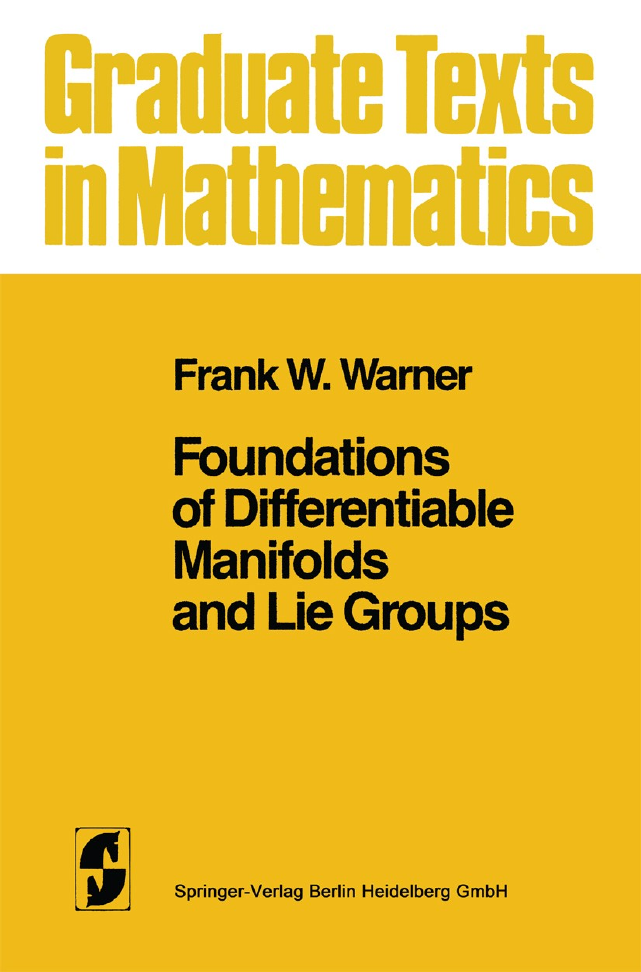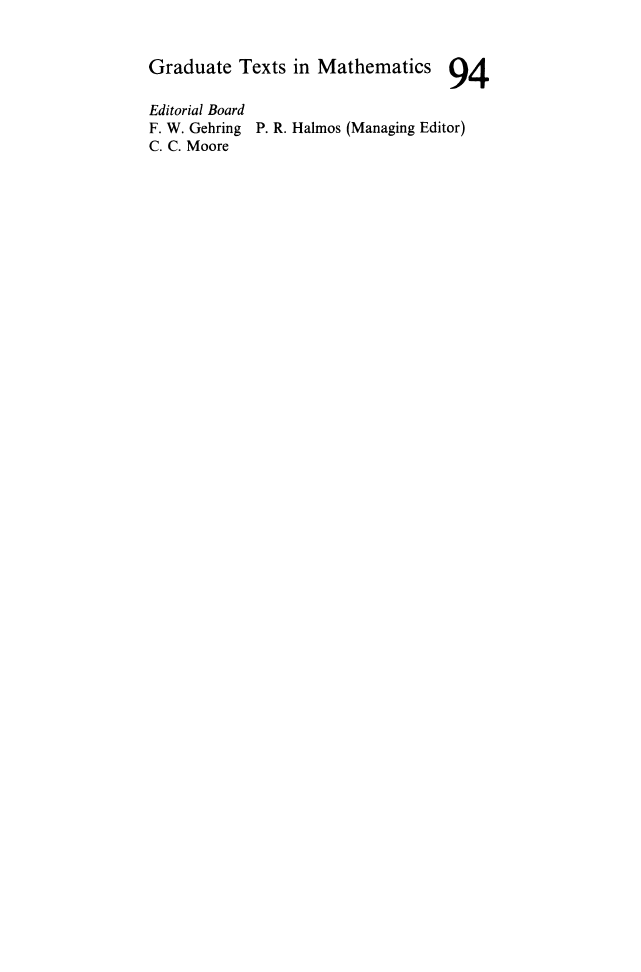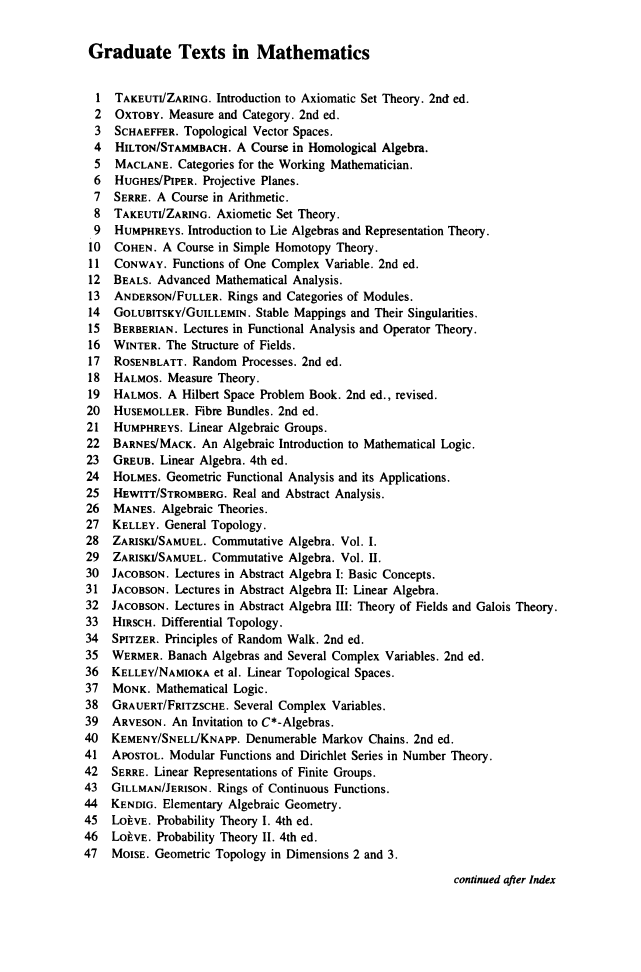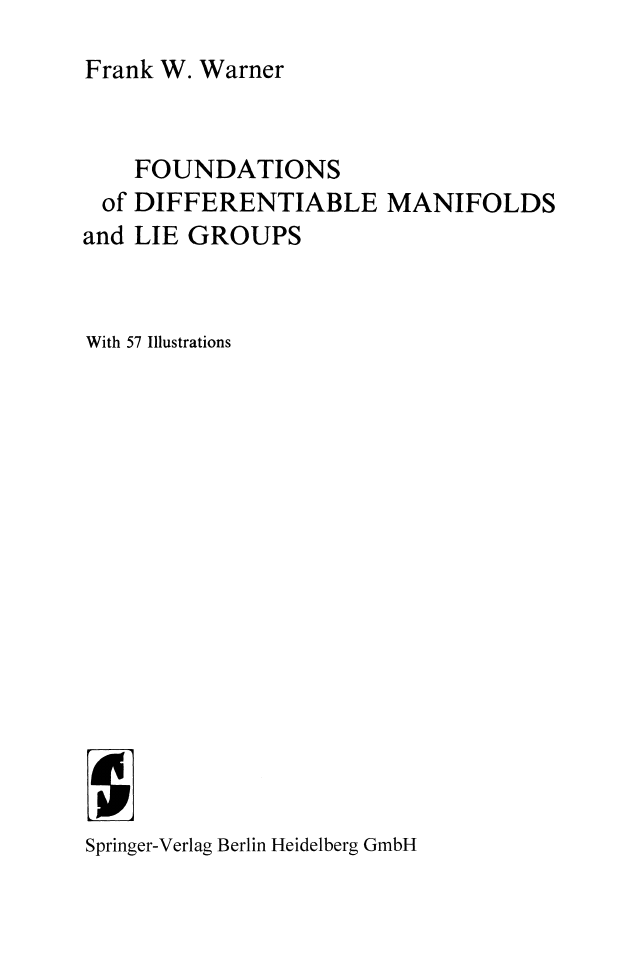�
Graduate Texts in Mathematics 94
Editorial Board
F. W. Gehring P. R. Halmos (Managing Editor)
C. C. Moore
Graduate Texts in Mathematics
TAKEUTI!ZARING. Introduction to Axiomatic Set Theory. 2nd ed.
2 OxTOBY. Measure and Category. 2nd ed.
3 ScHAEFFER. Topological Vector Spaces.
4 HILTON/STAMMBACH. A Course in Homological Algebra.
5 MACLANE. Categories for the Working Mathematician.
6 HUGHEs/PIPER. Projective Planes.
7 SERRE. A Course in Arithmetic.
8 T AKEUTI!ZARING. Axiometic Set Theory.
9 HUMPHREYS. Introduction to Lie Algebras and Representation Theory.
10 COHEN. A Course in Simple Homotopy Theory.
II CONWAY. Functions of One Complex Variable. 2nd ed.
12 BEALS. Advanced Mathematical Analysis.
13 ANDERSON/FuLLER. Rings and Categories of Modules.
14 GoLUBITSKYIGUILLEMIN. Stable Mappings and Their Singularities.
15 BERBERIAN. Lectures in Functional Analysis and Operator Theory.
16 WINTER. The Structure of Fields.
17 ROSENBLATT. Random Processes. 2nd ed.
18 HALMOS. Measure Theory.
19 HALMOS. A Hilbert Space Problem Book. 2nd ed., revised.
20 HUSEMOLLER. Fibre Bundles. 2nd ed.
21 HUMPHREYS. Linear Algebraic Groups.
22 BARNEs/MACK. An Algebraic Introduction to Mathematical Logic.
23 GREUB. Linear Algebra. 4th ed.
24 HoLMES. Geometric Functional Analysis and its Applications.
25 HEWITT/STROMBERG. Real and Abstract Analysis.
26 MANES. Algebraic Theories.
27 KELLEY. General Topology.
28 ZARISKI!SAMUEL. Commutative Algebra. Vol. I.
29 ZARISKIISAMUEL. Commutative Algebra. Vol. II.
30
31
32
33 HIRSCH. Differential Topology.
34 SPITZER. Principles of Random Walk. 2nd ed.
35 WERMER. Banach Algebras and Several Complex Variables. 2nd ed.
36 KELLEYINAMIOKA et al. Linear Topological Spaces.
37 MONK. Mathematical Logic.
38 GRAUERT/FRITZSCHE. Several Complex Variables.
39 ARVESON. An Invitation to C*-Aigebras.
40 KEMENY/SNELL/KNAPP. Denumerable Markov Chains. 2nd ed.
41 APOSTOL. Modular Functions and Dirichlet Series in Number Theory.
42 SERRE. Linear Representations of Finite Groups.
43 GILLMAN/1ERISON. Rings of Continuous Functions.
44 KENDIG. Elementary Algebraic Geometry.
45 LotvE. Probability Theory I. 4th ed.
46 LotvE. Probability Theory II. 4th ed.
47 MOISE. Geometric Topology in Dimensions 2 and 3.
JACOBSON. Lectures in Abstract Algebra 1: Basic Concepts.
JACOBSON. Lectures in Abstract Algebra II: Linear Algebra.
JACOBSON. Lectures in Abstract Algebra III: Theory of Fields and Galois Theory.
continued after Index
�
Frank W. Warner
FOUNDATIONS
of DIFFERENTIABLE MANIFOLDS
and LIE GROUPS
With 57 Illustrations
I
Springer-Verlag Berlin Heidelberg GmbH
�
Frank W. Warner
Vniversity of Pennsylvania
Department of Mathematics El
Philadelphia, PA 19104
V.S.A.
Editorial Board
P. R. Halmos
M anaging Editor
Indiana Vniversity
Department of
Mathematics
Bloomington, IN 47405
V.S.A.
F. W. Gehring
Vniversity of Michigan
Department of
Mathematics
Ann Arbor, MI 48109
V.S.A.
c. C. Moore
Vniversity of California
at Berkeley
Department of Mathematics
Berkeley, CA 94720
V.S.A.
AMS Subject Classification: 58-01
Library of Congress Cataloging in Publication Data
Warner, Frank W. (Frank Wilson11938-
Foundations of differentiable manifolds and Lie
groups.
(Graduate texts in mathematics; 94)
Reprint. Originally published: Glenview, Ill.: Scott,
Foresman, 1971.
Bibliography: p.
Inc1udes index.
1. Differentiable manifolds. 2. Lie groups. 1. Title.
II. Series.
QA614.3.w37 1983
512'.55
83-12395
Originally published © 1971 by Scott, Foresman and Co.
© 1983 by Frank W. Warner
Softcover reprint of the hardcover 1 st edition 1983
AlI rights reserved. No part of this book may be translated or reproduced in any
form without written permission from Springer-Verlag Berlin Heidelberg GmbH,
9 8 765 432 1
ISBN 978-1-4419-2820-7
DOI 10.1007/978-1-4757-1799-0
ISBN 978-1-4757-1799-0 (eBook)
�
This book provides the necessary foundation for students interested in any
of the diverse areas of mathematics which require the notion of a differentiable
manifold. It is designed as a beginning graduate-level textbook and presumes
a good undergraduate training in algebra and analysis plus some knowledge
It is
of point set topology, covering spaces, and the fundamental group.
also intended for use as a reference book since it includes a number of items
which are difficult to ferret out of the literature, in particular, the complete and
self-contained proofs of the fundamental theorems of Hodge and de Rham.
The core material is contained in Chapters I, 2, and 4. This includes
differentiable manifolds, tangent vectors, submanifolds, implicit function
theorems, vector fields, distributions and the Frobenius theorem, differential
forms, integration, Stokes' theorem, and de Rham cohomology.
Chapter 3 treats the foundations of Lie group theory, including the
relationship between Lie groups and their Lie algebras, the exponential
map, the adjoint representation, and the closed subgroup theorem. Many
examples are given, and many properties of the classical groups are derived.
The chapter concludes with a discussion of homogeneous manifolds. The
standard reference for Lie group theory for over two decades has been
Chevalley's Theory of Lie Groups, to which I am greatly indebted.
For the de Rham theorem, which is the main goal of Chapter 5, axiomatic
sheaf cohomology theory is developed. In addition to a proof of the strong
form of the de Rham theorem-the de Rham homomorphism given by
integration is a ring isomorphism from the de Rham cohomology ring to the
differentiable singular cohomology ring-it is proved that there are canonical
isomorphisms of all the classical cohomology theories on manifolds. The
pertinent parts of all these theories are developed in the text. The approach
which I have followed for axiomatic sheaf cohomology is due to H. Cartan,
who gave an exposition in his Seminaire 1950/1951.
For the Hodge theorem, a complete treatment of the local theory of
elliptic operators is presented in Chapter 6, using Fourier series as the basic
is presumed.
tool. Only a slight acquaintance with Hilbert spaces
I wish to thank Jerry Kazdan, who spent a large portion of the
summer of 1969 educating me to the whys and wherefores of inequalities
and who provided considerable assistance with the preparation of this chapter.
I also benefited from notes on lectures by J. J. Kohn and Stephen Andrea,
from several papers of Louis Nirenberg, and from Partial Differential
v
�
Preface
vi
Equations by Bers, John, and Schechter, which the reader might wish to
consult for further references to the literature.
At the end of each chapter is a set of exercises. These are an integral
part of the text. Often where a claim in a chapter has been left to the reader,
there is a reminder in the Exercises that the reader should provide a proof
of the claim. Some exercises are routine and test general understanding
of the chapter. Many present significant extensions of the text. In some
cases the exercises contain major theorems. Two notable examples are
properties of the eigenfunctions of the Laplacian and the Peter-Weyl theorem,
which are developed in the Exercises for Chapter 6. Hints are provided for
many of the difficult exercises.
There are a few notable omissions in the text. I have not treated complex
manifolds, although the sheaf theory developed in Chapter 5 will provide
the reader with one of the basic tools for the study of complex manifolds.
Neither have I treated infinite dimensional manifolds, for which I refer the
reader to Lang's Introduction to Differentiable Manifolds, nor Sard's theorem
and imbedding theorems, which the reader can find in Sternberg's Lectures
on Differential Geometry.
Several possible courses can be based on this text. Typical one-semester
courses would cover the core material of Chapters 1, 2, and 4, and then
either Chapter 3 or 5 or 6, depending on the interests of the class. The
entire text can be covered in a one-year course.
Students who wish to continue with further study in differential geometry
should consult such advanced texts as Differential Geometry and Symmetric
Spaces by Helgason, Geometry of Manifolds by Bishop and Crittenden, and
Foundations of Differential Geometry (2 vols.) by Kobayashi and Nomizu.
I am happy to express my gratitude to Professor I. M. Singer, from whom
I learned much of the material in this book and whose courses have always
generated a great excitement and enthusiasm for the subject.
Many people generously devoted considerable time and effort to reading
early versions of the manuscript and making many corrections and helpful
suggestions. I particularly wish to thank Manfredo do Carmo, Jerry Kazdan,
Stuart Newberger, Marc Rieffel, John Thorpe, Nolan Wallach, Hung-Hsi Wu,
and the students in my classes at the University of California at Berkeley and
at the University of Pennsylvania. My special thanks to Jeanne Robinson,
Marian Griffiths, and Mary Ann Hipple for their excellent job of typing, and
to Nat Weintraub of Scott, Foresman and Company for his cooperation and
excellent guidance and assistance in the final preparation of the manuscript.
Frank Warner
�
This Springer edition is a reproduction of the original Scott, Foresman
printing with the exception that the few mathematical and typographical
errors of which I am aware have been corrected. A few additional titles
have been added to the bibliography.
I am especially grateful to all those colleagues who wrote concerning
their experiences with the original edition. I received many fine suggestions
for improvements and extensions of the text and for some time debated the
possibility of writing an entirely new second edition. However, many of the
extensions I contemplated are easily accessible in a number of excellent
sources. Also, quite a few colleagues urged that I leave the text as it is.
Thus it is reprinted here basically unchanged. In particular, all of the
numbering and page references remain the same for the benefit of those
who have made specific references to this text in other publications.
In the past decade there have been remarkable advances in the applications
of analysis-especially the theory of elliptic partial differential equations, to
geometry-and in the application of geometry, especially the theory of
connections on principle fiber bundles, to physics. Some references to these
exciting developments as well as several excellent treatments of topics in
differential and Riemannian geometry, which students might wish to consult
in conjunction with or subsequent to this text, have been included in the
bibliography.
Finally, I want to thank Springer for encouraging me to republish this
text in the Graduate Texts in Mathematics series. I am delighted that it
has now come to pass.
Philadelphia, Pennsylvania
October, 1983
Frank Warner
vii
�
















 2023年江西萍乡中考道德与法治真题及答案.doc
2023年江西萍乡中考道德与法治真题及答案.doc 2012年重庆南川中考生物真题及答案.doc
2012年重庆南川中考生物真题及答案.doc 2013年江西师范大学地理学综合及文艺理论基础考研真题.doc
2013年江西师范大学地理学综合及文艺理论基础考研真题.doc 2020年四川甘孜小升初语文真题及答案I卷.doc
2020年四川甘孜小升初语文真题及答案I卷.doc 2020年注册岩土工程师专业基础考试真题及答案.doc
2020年注册岩土工程师专业基础考试真题及答案.doc 2023-2024学年福建省厦门市九年级上学期数学月考试题及答案.doc
2023-2024学年福建省厦门市九年级上学期数学月考试题及答案.doc 2021-2022学年辽宁省沈阳市大东区九年级上学期语文期末试题及答案.doc
2021-2022学年辽宁省沈阳市大东区九年级上学期语文期末试题及答案.doc 2022-2023学年北京东城区初三第一学期物理期末试卷及答案.doc
2022-2023学年北京东城区初三第一学期物理期末试卷及答案.doc 2018上半年江西教师资格初中地理学科知识与教学能力真题及答案.doc
2018上半年江西教师资格初中地理学科知识与教学能力真题及答案.doc 2012年河北国家公务员申论考试真题及答案-省级.doc
2012年河北国家公务员申论考试真题及答案-省级.doc 2020-2021学年江苏省扬州市江都区邵樊片九年级上学期数学第一次质量检测试题及答案.doc
2020-2021学年江苏省扬州市江都区邵樊片九年级上学期数学第一次质量检测试题及答案.doc 2022下半年黑龙江教师资格证中学综合素质真题及答案.doc
2022下半年黑龙江教师资格证中学综合素质真题及答案.doc